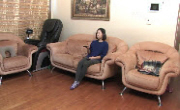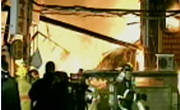내화강재의 고온시 기계적 특성에 대한 연구가 많이 미흡하다. 기존 국외설계기준에서 제시하는 고온 재료모델은 일반 탄소강재의 실험결과를 바탕으로 제안되었기 때문에 제강과정에서 ...
http://chineseinput.net/에서 pinyin(병음)방식으로 중국어를 변환할 수 있습니다.
변환된 중국어를 복사하여 사용하시면 됩니다.
- 中文 을 입력하시려면 zhongwen을 입력하시고 space를누르시면됩니다.
- 北京 을 입력하시려면 beijing을 입력하시고 space를 누르시면 됩니다.

내화구조 시뮬레이션을 위한 FR355 내화강의 고온특성 및 구성모델 = Elevated-temperature Material Properties and Constitutive Model of Fire Resistant Steel for Thermo-mechanical Simulation
한글로보기https://www.riss.kr/link?id=A108963497
- 저자
- 발행기관
- 학술지명
- 권호사항
-
발행연도
2024
-
작성언어
Korean
- 주제어
-
등재정보
KCI등재
-
자료형태
학술저널
-
수록면
91-102(12쪽)
- DOI식별코드
- 제공처
- 소장기관
-
0
상세조회 -
0
다운로드
부가정보
국문 초록 (Abstract)
내화강재의 고온시 기계적 특성에 대한 연구가 많이 미흡하다. 기존 국외설계기준에서 제시하는 고온 재료모델은 일반 탄소강재의 실험결과를 바탕으로 제안되었기 때문에 제강과정에서 합금원소를 첨가하여 강재의 내화성능을 향상시킨 내화강재에 적용가능 여부가 불투명하다. 이 연구에서는 정상상태 인장실험을 결과를 바탕으로 FR355 강재의 고온 기계적 특성을 평가하였다. 화재시, 강구조부재는 연성파괴모드에 지배되지만, 강재의 파괴특성과 탄소성 모델이 미흡하여 이를 시뮬레이션화 하기에는 많은 제약이 있다. 따라서, 이 연구에서는 내화강재가 적용된 건축물의 성능기반 내화설계 유한요소해석에 필요한 기초 데이터를 제공하고자 장범위진응력-진변형률, 연성파괴특성을 효율적으로 획득하고 시뮬레이션하는 기법을 제안하였다.
다국어 초록 (Multilingual Abstract)
They differ from material model codified in the existing design codes that are mainly based on the results of mild carbon steel.
This paper investigates the elevated-temperature material properties of FR355 through steady-state tensile tests. Ductile fracture in steel structural components in a fire has been widely observed. However, its inclusion in numerical simulation has been limited due to lack of experimental data on fracture response and true stress-strain data. This paper also addresses an integrated experimental-FE analysis to calibrate ductile fracture parameters and to determine full-range true stress-strain curves. The developed material constitutive model and ductile fracture model were validated through extensive simulations of tensile coupons at elevated temperatures.
Elevated-temperature material properties of fire resistant steel reported in the literature have an observable scatter. They differ from material model codified in the existing design codes that are mainly based on the results of mild carbon steel. Th...
Elevated-temperature material properties of fire resistant steel reported in the literature have an observable scatter.
They differ from material model codified in the existing design codes that are mainly based on the results of mild carbon steel.
This paper investigates the elevated-temperature material properties of FR355 through steady-state tensile tests. Ductile fracture in steel structural components in a fire has been widely observed. However, its inclusion in numerical simulation has been limited due to lack of experimental data on fracture response and true stress-strain data. This paper also addresses an integrated experimental-FE analysis to calibrate ductile fracture parameters and to determine full-range true stress-strain curves. The developed material constitutive model and ductile fracture model were validated through extensive simulations of tensile coupons at elevated temperatures.
동일학술지(권/호) 다른 논문
-
비선형 단자유도 모델을 활용한 마찰감쇠 천장시스템의 해석과 설계
- 한국강구조학회
- 이승준
- 2024
- KCI등재
-
시간-등가 방법을 이용한 필로티 구조물의 차량화재에 대한 공간온도평가
- 한국강구조학회
- 이한솔
- 2024
- KCI등재
-
- 한국강구조학회
- 하민균
- 2024
- KCI등재
-
- 한국강구조학회
- 김동원
- 2024
- KCI등재




 DBpia
DBpia







